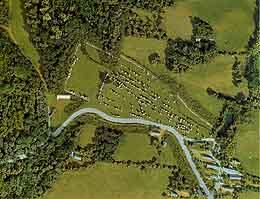- Home
- Megalithism in Morbihan
- Carnac
- Kerlescan
The third group of standing stones in Carnac is found further to the east. It is the smallest but probably the best preserved of the groups. Several features make it unique:
- it is clearly oriented from east to west (and not south-west to north-east),
- the layout is exceptionally compact (only 350m in length with 13 lines initially spread over a width of 140m),
- at least one section of lines (the southernmost lines) is clearly arranged in a fan-shaped pattern open to the west towards the enclosure,
- the northern lines are subparallel, their length decreasing as they approach the periphery, creating a fan shape impression similar to that visible to the south,
- in the centre, two of the longest lines seem to form a "main avenue" leading in the direction of the north-western corner of the enclosure,
- the enclosure is almost square (80x90m), its 39 remaining stones neatly marking three sides of the square (the fourth side, to the north, has completely disappeared).
Next slide
Previous slide
Scale model of the Kerlescan group. The large enclosure is located in the wood to the north of the quadrangular enclosure and its neighbouring mound.
A line of almost contiguous blocks forms the eastern side of the enclosure, separating it from the lines of menhirs.
The megalithic monuments surrounding the Kerlescan group are particularly interesting.
- A large mound (98m long, 15m wide, 2m high) adjoins the northern side of the western enclosure. It has been excavated several times (the last occasion was during the war), but always in precarious conditions. However, it is known that it covers a set of stone "hearths" and "cists" circled by small standing blocks.
- The great menhir known as "the Manio Giant" stands 300m away to the west of the Kerlescan enclosure, practically in line with the main lines. The menhir and its neighbouring mounds connect with the eastern end of the Kermario alignments.
- A large horseshoe-shaped enclosure (280m in diameter) is located right after the Kerlescan mound, in a northerly direction. It is widely open to the east and consists of about forty blocks.
- A "lateral entrance" tomb is situated 200m to the north of the eastern side of the monument.
Early perspective of the Kerlescan group showing the long tumulus adjacent to the quadrangular enclosure (bottom left corner).


